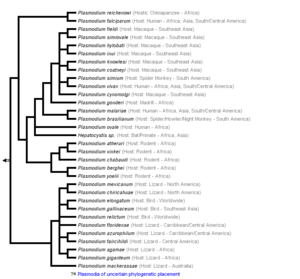Malaria resistance as a result of genetic mutation: Difference between revisions
No edit summary |
|||
| Line 29: | Line 29: | ||
=='''Section 1 Genetics'''== | =='''Section 1 Genetics'''== | ||
==<u>Mechanism of protection</u>== | |||
It turns out that one of the protective effects which prevented the development of parasites inside the red blood cells was heme oxygenase-1, an enzyme whose expression is strongly induced by sickle hemoglobin. This enzyme produces carbon monoxide, which levels are not high enough to poison the host itself, but enough to be lethal for the plasmodium parasite. Therefore, a heterozygous host for a sickle cell gene is prevented from experiencing malaria symptoms since the parasite could not enter the red blood cells and reproduce. | |||
=='''Section 2 Microbiome'''== | =='''Section 2 Microbiome'''== | ||
Revision as of 20:55, 8 December 2021
Introduction
Malaria
Malaria is a life-threatening disease spread by the bite of an infected female Anopheles mosquito, which is considered a primary vector of the illness. That is why such a mosquito is also known as the Malaria Mosquito. The infection is caused by plasmodium, a parasitic protozoans sporozoan subclass Coccidia genus. Plasmodium infects red blood cells across various animals worldwide, such as mammals, birds, and reptiles. However, out of more than two hundred Plasmodium species, only four are responsible for malaria in humans - Plasmodium falciparum, Plasmodium vivax, Plasmodium malariae, Plasmodium ovale, and Plasmodium knowlesi. The last has been recently documented, causing infection in the regions of Southeast Asia. Nevertheless, malaria is most common in the tropical and subtropical regions, where the climate is dry with less precipitation: South and Southeast Asia, Sub-Saharan Africa, being the home of more than 90% of malaria cases globally. Malaria parasites affect the host by attacking the red blood cells to invade the immune system and remodel erythrocytes for their own use. The enzyme plasmepsin V in the malaria parasite can export hundreds of proteins that remodel the host's red blood cell, eventually annihilating it. The released parasite proteins destroy the oxygen-carrying hemoglobin and deform the cell surface. That, in turn, causes erythrocytes to stick to blood vessels and prevents the cells from circulation freely. The parasite uses this strategy of invading the red blood cells to hide from the host immune system, as white blood cells do not attack erythrocytes unless they are someone else's.

Sickle-cell Anemia
Sickle-cell anemia is an inherited disorder that affects red blood cells. Erythrocytes contain a red protein molecule hemoglobin that carries iron, which holds oxygen, thereby transporting the supply of oxygen throughout the body vessels. Typically, red blood cells tend to be round and flexible, which allows them to bend to move freely even through the narrowest blood vessels. However, individuals affected by sickle cell anemia have a mutation in the hemoglobin gene, which happens on the sixth codon of the beta chain of hemoglobin. The sequence of bases CTC is changed to CAC. Such variation in the gene does not code for the Glutamic acid anymore but instead for Valine. A change in hemoglobin gene information causes the hemoglobin to form strands inside the erythrocyte, making them inflexible and giving them a symbolic sickle-like shape. Such altered versions of red blood cells can cause blockages in the section of blood vessels, leading to sickle cell crisis due to the inability of red blood cells to supply all tissues and organs with oxygen. For disease expression, either two copies of sickle hemoglobin (Hb S) or one in addition to the normal beta-globin gene (Hb N) are required.

Relationship between malaria endemicity and frequency of mutated hemoglobin gene
There is geographical support for a correlation between the high frequencies of the hemoglobin gene responsible for sickle cell disease and resistance against malaria by the heterozygous carrier of the beta-globin gene. Such correlation is the strongest in Africa, where Hb S allele frequencies and the level of malaria endemicity showed the highest numbers. [1] Another study conducted in one of the hospitals in Cameroon concluded that individuals with expressed sickle cell anemia had a lower mortality rate than individuals with unmutated beta chain hemoglobin. [2]
At right is a sample image insertion. It works for any image uploaded anywhere to MicrobeWiki. The insertion code consists of:
Double brackets: [[
Filename: PHIL_1181_lores.jpg
Thumbnail status: |thumb|
Pixel size: |300px|
Placement on page: |right|
Legend/credit: Electron micrograph of the Ebola Zaire virus. This was the first photo ever taken of the virus, on 10/13/1976. By Dr. F.A. Murphy, now at U.C. Davis, then at the CDC.
Closed double brackets: ]]
Other examples:
Bold
Italic
Subscript: H2O
Superscript: Fe3+
I don't know
Section 1 Genetics
Mechanism of protection
It turns out that one of the protective effects which prevented the development of parasites inside the red blood cells was heme oxygenase-1, an enzyme whose expression is strongly induced by sickle hemoglobin. This enzyme produces carbon monoxide, which levels are not high enough to poison the host itself, but enough to be lethal for the plasmodium parasite. Therefore, a heterozygous host for a sickle cell gene is prevented from experiencing malaria symptoms since the parasite could not enter the red blood cells and reproduce.
Section 2 Microbiome

Include some current research, with a second image.
Conclusion
Overall text length (all text sections) should be at least 1,000 words (before counting references), with at least 2 images.
Include at least 5 references under References section.
References
Edited by [Karan Mehta], student of Joan Slonczewski for BIOL 116 Information in Living Systems, 2021, Kenyon College.
